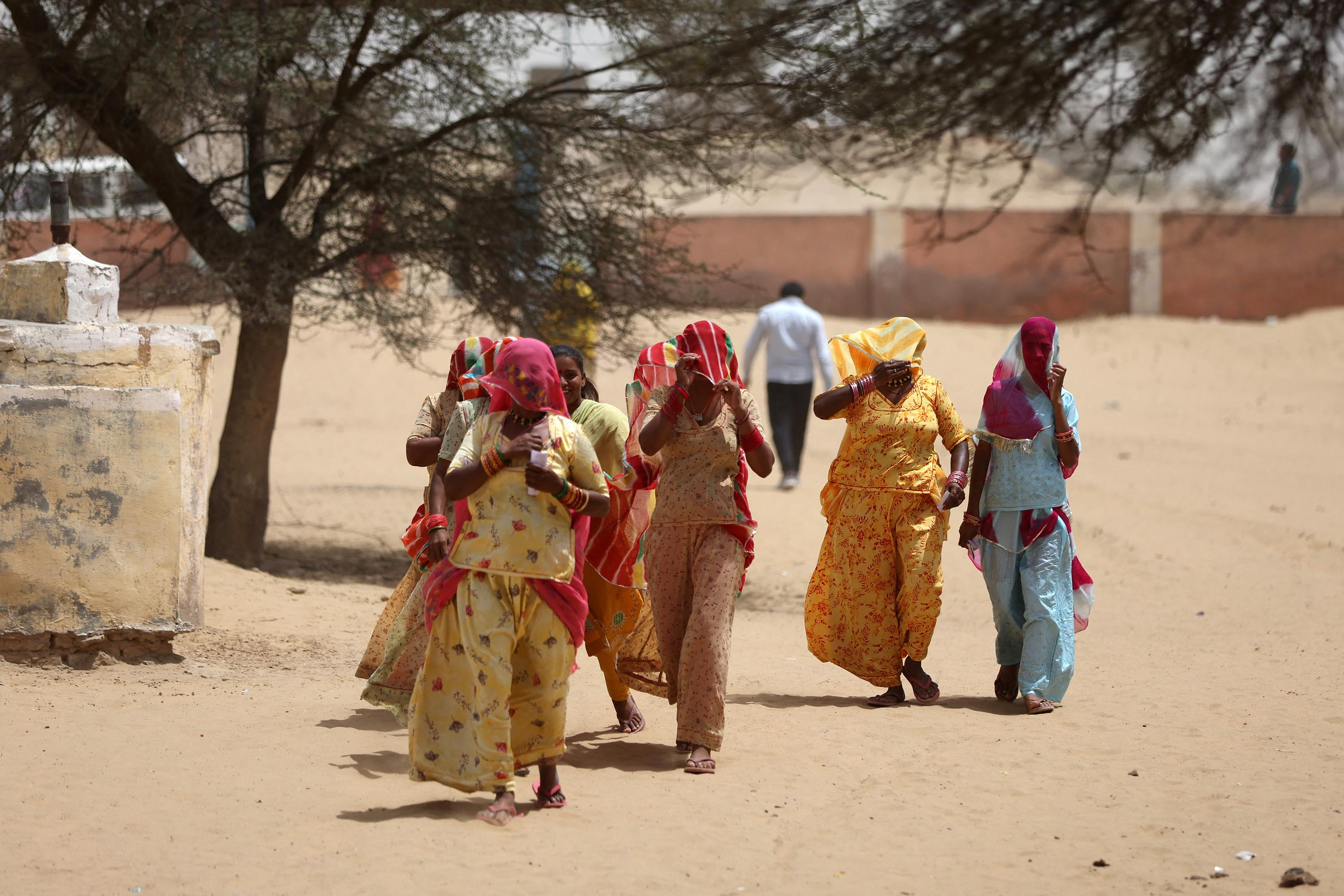A “staggering” number of workers are exposed to a toxic cocktail of health risks linked to climate change and they are not sufficiently protected by existing regulations, the UN warned on Monday. Increased frequency and severity of heatwaves, heavy rainfall, forest fires, droughts, tropical cyclones... Workers, particularly those outdoors, are on the front line of the consequences of global warming, warns the latest report, Ensuring the occupational safety and health in times of climate change from the World Labor Organization (ILO).
The latter are exposed to these phenomena “often for longer periods and at higher intensities than the general population”, conclude the specialists. While in 2023, according to NASA, the month of July was the hottest on record, the climate crisis “creates serious health risks for 70% of workers around the world”. The time is no longer just for prevention: the variation in temperatures and the multiplicity of extreme phenomena are already having serious impacts on the safety and health of workers in all regions of the world. The ILO estimates that more than 2.4 billion workers on the planet (out of a total workforce of 3.4 billion) are “likely to be exposed to excessive heat at one time or another. »
This proportion has increased from 65.5% to 70.9% since 2000. According to the report, 18,970 lives and more than 2 million years of life are lost each year. Not to mention the 26.2 million people worldwide who suffer from chronic kidney disease linked to heat stress in the workplace.
Working conditions are becoming more difficult in many exposed industries. For example, excessive heat reduces productivity in agriculture, construction and other sectors. A study by the National Bureau of Economic Research (NBER) showed that every day the temperature exceeds 32°C in the United States, there is a 1.7% drop in production. Agriculture, tourism and fishing are particularly sensitive to extreme weather conditions. Fluctuations in these industries can lead to job losses and economic upheaval in regions that rely heavily on them.
Climate change causes multiple health problems, such as cancers, cardiovascular diseases, respiratory diseases, kidney dysfunctions and mental health problems (depression, anxiety, irritability, suicide, etc.). The report cites in detail:
- 1.6 billion workers exposed to UV rays, with more than 18,960 work-related deaths each year due to non-melanoma skin cancer.
- 1.6 billion people likely to be exposed to air pollution in the workplace, leading to up to 860,000 work-related deaths among outdoor workers each year.
- More than 870 million agricultural workers are at risk of exposure to pesticides, with more than 300,000 deaths attributed to pesticide poisoning each year.
- 15,000 work-related deaths each year due to exposure to diseases caused by parasites (such as malaria, Editor's note).
The financial consequences for employers are also legion, due to lost productivity, business interruption and damaged infrastructure, as well as the costs associated with climate change mitigation and adaptation measures as new regulations come into force. Certain sectors, such as agriculture, energy, heavy industry and manufacturing, transport and construction, are expected to be significantly affected by climate change and the transition to zero carbon.
“Alarmingly”, heat stress “is expected to reduce global GDP by $2.4 trillion in 2030.” The report finds that the impact is unevenly distributed geographically, with the expected reduction in working hours in 2030 amounting to around 5% in South Asia and West Africa, and 0.5% in South Africa. and West Africa, and 0.1% in the European sub-regions
Another impact is that if global temperatures rise by 2°C by the end of the century, asylum applications to the European Union (EU) are expected to double.
Even if global warming is limited to 1.5°C above pre-industrial levels by the end of the century, cumulative financial losses from heat-related illnesses alone are expected to reach $2.4 billion. In the United States, the health costs of air pollution and climate change “already well exceed $800 billion per year” and this figure is only expected to grow.
In 2021, a study found that even a “modest” increase in workplace temperatures led to 20,000 additional accidents per year in California, with a social cost of $1 billion. By comparing records from 2001 to 2018 of more than 11 million California workers' compensation claims to local high-frequency weather data, the authors isolated the impact of warmer days on the number of claims. The study shows that on days when temperatures are above 90°F (about 32°C), workers have a 6 to 9 percent higher risk of injury than on days when temperatures are below 50 or 60° . When the thermometer exceeds 38°C, the risk of injury increases by 10 to 15%.

 What is chloropicrin, the chemical agent that Washington accuses Moscow of using in Ukraine?
What is chloropicrin, the chemical agent that Washington accuses Moscow of using in Ukraine? Poland, big winner of European enlargement
Poland, big winner of European enlargement In Israel, step-by-step negotiations for a ceasefire in the Gaza Strip
In Israel, step-by-step negotiations for a ceasefire in the Gaza Strip BBVA ADRs fall almost 2% on Wall Street
BBVA ADRs fall almost 2% on Wall Street Children born thanks to PMA do not have more cancers than others
Children born thanks to PMA do not have more cancers than others Breast cancer: less than one in two French women follow screening recommendations
Breast cancer: less than one in two French women follow screening recommendations “Dazzling” symptoms, 5,000 deaths per year, non-existent vaccine... What is Lassa fever, a case of which has been identified in Île-de-France?
“Dazzling” symptoms, 5,000 deaths per year, non-existent vaccine... What is Lassa fever, a case of which has been identified in Île-de-France? Sánchez cancels his agenda and considers resigning: "I need to stop and reflect"
Sánchez cancels his agenda and considers resigning: "I need to stop and reflect" “Amazon product tester”: the gendarmerie warns of this new kind of scam
“Amazon product tester”: the gendarmerie warns of this new kind of scam “Unjustified allegations”, “promotion of illicit products”… Half of the influencers controlled in 2023 caught by fraud repression
“Unjustified allegations”, “promotion of illicit products”… Half of the influencers controlled in 2023 caught by fraud repression Extension of the RER E: Gabriel Attal welcomes a “popular” ecology project
Extension of the RER E: Gabriel Attal welcomes a “popular” ecology project WeWork will close 8 of its 20 shared offices in France
WeWork will close 8 of its 20 shared offices in France “We were robbed of this dignity”: Paul Auster’s wife denounces the betrayal of a family friend
“We were robbed of this dignity”: Paul Auster’s wife denounces the betrayal of a family friend A masterclass for parents to fill in their gaps before Taylor Swift concerts
A masterclass for parents to fill in their gaps before Taylor Swift concerts Jean Reno publishes his first novel Emma on May 16
Jean Reno publishes his first novel Emma on May 16 Cannes Film Festival: Meryl Streep awarded an honorary Palme d’Or
Cannes Film Festival: Meryl Streep awarded an honorary Palme d’Or Omoda 7, another Chinese car that could be manufactured in Spain
Omoda 7, another Chinese car that could be manufactured in Spain BYD chooses CA Auto Bank as financial partner in Spain
BYD chooses CA Auto Bank as financial partner in Spain Tesla and Baidu sign key agreement to boost development of autonomous driving
Tesla and Baidu sign key agreement to boost development of autonomous driving Skoda Kodiaq 2024: a 'beast' plug-in hybrid SUV
Skoda Kodiaq 2024: a 'beast' plug-in hybrid SUV The home mortgage firm rises 3.8% in February and the average interest moderates to 3.33%
The home mortgage firm rises 3.8% in February and the average interest moderates to 3.33% This is how housing prices have changed in Spain in the last decade
This is how housing prices have changed in Spain in the last decade The home mortgage firm drops 10% in January and interest soars to 3.46%
The home mortgage firm drops 10% in January and interest soars to 3.46% The jewel of the Rocío de Nagüeles urbanization: a dream villa in Marbella
The jewel of the Rocío de Nagüeles urbanization: a dream villa in Marbella Europeans: a senior official on the National Rally list
Europeans: a senior official on the National Rally list Blockade of Sciences Po: the right denounces a “drift”, the government charges the rebels
Blockade of Sciences Po: the right denounces a “drift”, the government charges the rebels Even on a mission for NATO, the Charles-de-Gaulle remains under French control, Lecornu responds to Mélenchon
Even on a mission for NATO, the Charles-de-Gaulle remains under French control, Lecornu responds to Mélenchon “Deadly Europe”, “economic decline”, immigration… What to remember from Emmanuel Macron’s speech at the Sorbonne
“Deadly Europe”, “economic decline”, immigration… What to remember from Emmanuel Macron’s speech at the Sorbonne These French cities that will boycott the World Cup in Qatar
These French cities that will boycott the World Cup in Qatar Champions Cup: Toulouse with Flament and Kinghorn against Harlequins, Ramos replacing
Champions Cup: Toulouse with Flament and Kinghorn against Harlequins, Ramos replacing Tennis: still injured in the arm, Alcaraz withdraws from the Masters 1000 in Rome
Tennis: still injured in the arm, Alcaraz withdraws from the Masters 1000 in Rome Sailing: “Like a house that threatens to collapse”, Clarisse Crémer exhausted and in tears aboard her damaged boat
Sailing: “Like a house that threatens to collapse”, Clarisse Crémer exhausted and in tears aboard her damaged boat NBA: Patrick Beverley loses his temper and throws balls at Pacers fans
NBA: Patrick Beverley loses his temper and throws balls at Pacers fans


















